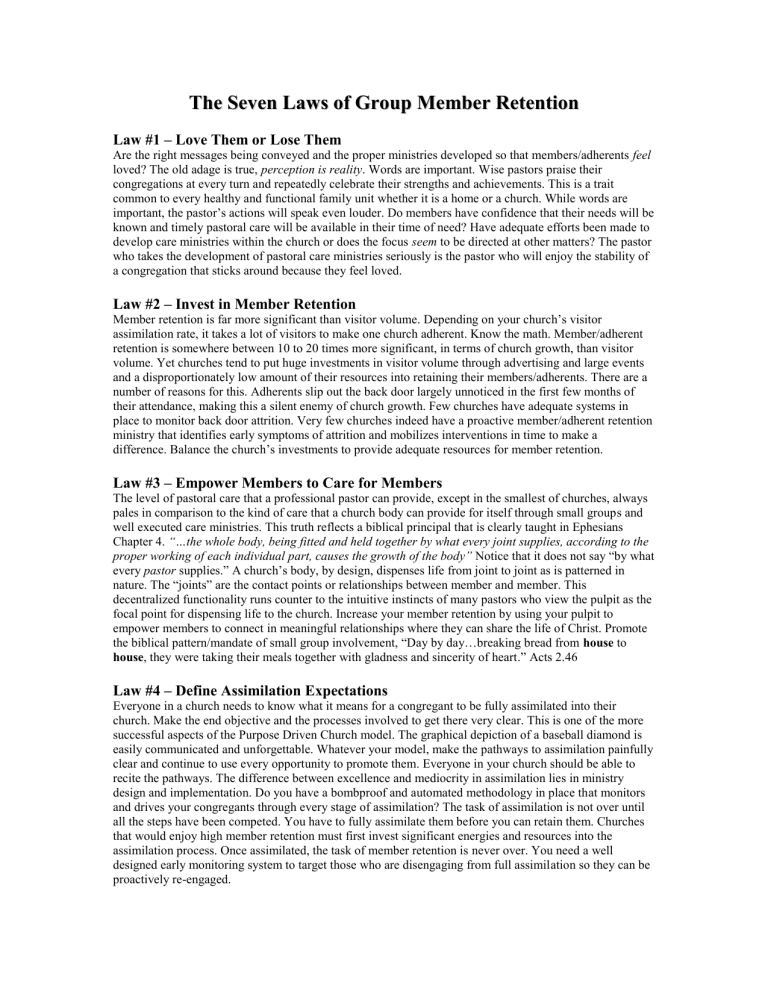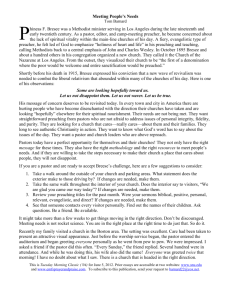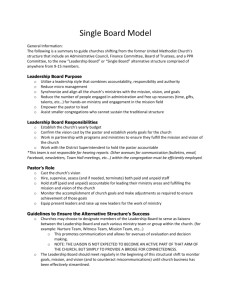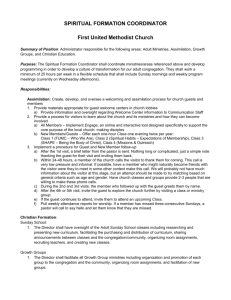7 Laws of Group Member Retention: Church Growth Strategies

T h e S e v e n L a w s s o f f G r o u p M e m b e r R e t t e n t t i i o n
Law #1 – Love Them or Lose Them
Are the right messages being conveyed and the proper ministries developed so that members/adherents feel loved? The old adage is true, perception is reality . Words are important. Wise pastors praise their congregations at every turn and repeatedly celebrate their strengths and achievements. This is a trait common to every healthy and functional family unit whether it is a home or a church. While words are important, the pastor’s actions will speak even louder. Do members have confidence that their needs will be known and timely pastoral care will be available in their time of need? Have adequate efforts been made to develop care ministries within the church or does the focus seem to be directed at other matters? The pastor who takes the development of pastoral care ministries seriously is the pastor who will enjoy the stability of a congregation that sticks around because they feel loved.
Law #2 – Invest in Member Retention
Member retention is far more significant than visitor volume. Depending on your church’s visitor assimilation rate, it takes a lot of visitors to make one church adherent. Know the math. Member/adherent retention is somewhere between 10 to 20 times more significant, in terms of church growth, than visitor volume. Yet churches tend to put huge investments in visitor volume through advertising and large events and a disproportionately low amount of their resources into retaining their members/adherents. There are a number of reasons for this. Adherents slip out the back door largely unnoticed in the first few months of their attendance, making this a silent enemy of church growth. Few churches have adequate systems in place to monitor back door attrition. Very few churches indeed have a proactive member/adherent retention ministry that identifies early symptoms of attrition and mobilizes interventions in time to make a difference. Balance the church’s investments to provide adequate resources for member retention.
Law #3 – Empower Members to Care for Members
The level of pastoral care that a professional pastor can provide, except in the smallest of churches, always pales in comparison to the kind of care that a church body can provide for itself through small groups and well executed care ministries. This truth reflects a biblical principal that is clearly taught in Ephesians
Chapter 4.
“…the whole body, being fitted and held together by what every joint supplies, according to the proper working of each individual part, causes the growth of the body” Notice that it does not say “by what every pastor supplies.” A church’s body, by design, dispenses life from joint to joint as is patterned in nature. The “joints” are the contact points or relationships between member and member. This decentralized functionality runs counter to the intuitive instincts of many pastors who view the pulpit as the focal point for dispensing life to the church. Increase your member retention by using your pulpit to empower members to connect in meaningful relationships where they can share the life of Christ. Promote the biblical pattern/mandate of small group involvement, “Day by day…breaking bread from house to house , they were taking their meals together with gladness and sincerity of heart.” Acts 2.46
Law #4 – Define Assimilation Expectations
Everyone in a church needs to know what it means for a congregant to be fully assimilated into their church. Make the end objective and the processes involved to get there very clear. This is one of the more successful aspects of the Purpose Driven Church model. The graphical depiction of a baseball diamond is easily communicated and unforgettable. Whatever your model, make the pathways to assimilation painfully clear and continue to use every opportunity to promote them. Everyone in your church should be able to recite the pathways. The difference between excellence and mediocrity in assimilation lies in ministry design and implementation. Do you have a bombproof and automated methodology in place that monitors and drives your congregants through every stage of assimilation? The task of assimilation is not over until all the steps have been competed. You have to fully assimilate them before you can retain them. Churches that would enjoy high member retention must first invest significant energies and resources into the assimilation process. Once assimilated, the task of member retention is never over. You need a well designed early monitoring system to target those who are disengaging from full assimilation so they can be proactively re-engaged.
Law #5 – Use Them Or Lose Them
It is essential to the spiritual health of every believer that they develop into a functional member of the
Body of Christ. Functional means that they are not just passive consumers of Kingdom resources but they become active in service which in turn makes them a valued Kingdom resource. Nature teaches that members of a body that cease to function atrophy and become a burden to the whole system. When this reaches critical mass congregational morale plummets in the few who feel they are “doing all the work.”
This is an environment that leads to member attrition. There is no greater thrill for the Christian than to discover that God created them for a specific purpose in life. Purposelessness is the bane of hopes, dreams, joy, and contentment. Want a happy and contented church with high levels of member retention? Help your congregants find a place of meaningful Kingdom service and experience the incredible fulfillment that comes from making a difference for eternity. Help them to discover their God-given gifts and where they can best fit in the ministries of the church. Work ceaselessly to create new ministries and ministry positions that provide an ever increasingly rich environment for Kingdom service. Develop marketing channels and a strong competency to market ministry opportunities to your congregants.
Law #6 – Grow Them
Nothing closes the back door more firmly for people than the conviction that they are making real spiritual progress at their church. These people become raving fans that not only increase member retention but also visitor volume by communicating their excitement with outsiders. Churches that provide an atmosphere that is highly conducive to spiritual growth have a few key commonalities. Growth means that the Bible becomes relevant to the daily lives of congregants. Maintaining the weekly discipline of sermon preparation has to be a top priority of the pastor. The message is not complete without a practical sermon application that integrates truth into the daily lives of your congregation. Practical issues such as relationships, conflict resolution, temptation, the workplace, etc. need to be addressed. Growth means that congregants are growing in biblical literacy. A world view begins to emerge that has its foundations in
Judeo Christian values which permeate every area of life and thought. Perspectives change as a broad awareness of biblical history provides context for the present. The broader themes and principles of the
Bible have been absorbed and are being integrated into attitudes. Teaching and study opportunities need to be made available in addition to the weekly sermons. Growth means that worship fills the heart of the believer as they grasp the personal nature of God’s love for them. Spiritual awareness blossoms and worshippers begin to change from the inside out. The church needs to provide heartfelt corporate worship that fans this spark into a flame. Growth means that the believer has become engaged in spiritually meaningfully relationships with other Christians on a regular basis. These relationships provide mutual support, accountability and opportunities to minister. The church needs to earnestly foster the ongoing development of small groups that facilitate this kind of interaction. Finally, growth means that congregants have become active in service to others as outlined in Law 6 above.
Law #7 – Speak Clearly and Often
Pastors and staff need to communicate clearly and often to their congregations. Three formidable monsters live in the realm of poor communications. They are called assumptions, intentions and expectations. Say what you will do, when you will do it and how you will do it. Then do it that way. Be predictable. Jesus put it this way, “Let your yes be yes.” Accept the consequences of your words especially when circumstances make it uncomfortable to follow through. When the pastor communicates clearly, in a timely fashion, and always follows through, it builds trust and confidence in leadership which greatly increases member retention. Pastors are generally gifted at oral communications. Yet regular written correspondence from the pastor is an indispensable channel of meaningful communication. Be positive in everything you say or write. The effort to formalize one’s thoughts into writing invariably adds to the clarity and breadth of thoughts shared. Letters, newsletters, e-newsletters, emails and website postings are all effective. Make your intentions, plans, priorities and your vision clear by repeating them over and over using every available means at every opportunity.
2






